Damage Severity Assessment of Multi-Layer Complex Structures Based on a Damage Information Extraction Method with Ladder Feature Mining
Abstract
1. Introduction
2. Lamb Wave Propagation Theory in Plate Structures
3. Method
3.1. Damage Information Selection Stage
- According to the propagation law and propagation characteristics of the Lamb wave in the multi-layer complex structure, a suitable monitoring frequency range A0–A1 is selected.
- When the multi-layer complex structure is damaged to different degrees, we compare the damage signals with the baseline signals under the monitoring frequency range A0–A1. The time domain feature information is analyzed after extracting the time domain features, such as the correlation coefficient, maximum value, variance and root mean square. The frequency selection range is gradually narrowed down, and, finally, a most sensitive frequency band B0–B1 is determined. In this experiment, the selected optimal frequency band difference is 20 kHz.
- Within the monitoring frequency of B0–B1, the frequency domain analysis based on Fast Fourier Transform (FFT) is carried out on the scattered signals of different degrees. Through the peak analysis of the spectrum, a common sensitive frequency C0 is obtained, which is the optimal damage monitoring frequency.
3.2. Damage Feature Fusion Stage
3.2.1. Multi-Dimensional Feature Extraction
3.2.2. Dual Feature Fusion
- Obtain the value of the best decision tree. The feature matrix XNEW and the target variable matrix y are separated. Different numbers of decision trees are iterated by setting the seed of the random number generator. Each run evaluates the MSE and selects the number of decision trees Nt that minimizes the MSE. The formula is as follows:
- 2.
- Obtain feature importance. Construct the RF model using the optimal number of decision trees. The feature importance scores are obtained by enabling the calculation of feature importance for out-of-bag (OOB) sample prediction errors. The importance of features φ can be expressed as follows:
- 3.
- Feature selection: The features are ranked according to their importance. The top 50% of features in terms of importance are filtered from highest to lowest to complete the first damage feature fusion. The feature set obtained from this feature dimension optimization process is XNEW’.
4. Experimental Program
4.1. Multi-Layer Complex Structure Preparation
4.2. Sensor Signal Test
4.3. Verification of Damage Monitoring Ability
5. Results and Discussion
5.1. Guided Wave Signal Analysis of Multi-Layer Complex Structure
5.1.1. Structural Signal Testing and Analysis
5.1.2. Damage Signal Processing
5.2. Dual Damage Information Selection Based on Time and Frequency Domains
5.3. Dual Damage Feature Fusion Based on Dimension Optimization and Dimension Fusion
5.4. Damage Severity Identification Results
6. Conclusions
Author Contributions
Funding
Institutional Review Board Statement
Informed Consent Statement
Data Availability Statement
Conflicts of Interest
References
- Garg, A.; Chalak, H.D. A review on analysis of laminated composite and sandwich structures under hygrothermal conditions. Thin-Walled Struct. 2019, 142, 205–226. [Google Scholar] [CrossRef]
- Zhang, X.L.; Xu, Y.; Zhang, X.; Wu, H.; Shen, J.B.; Chen, R.; Xiong, Y.; Li, J.; Guo, S.Y. Progress on the layer-by-layer assembly of multilayered polymer composites: Strategy, structural control and applications. Prog. Polym. Sci. 2019, 89, 76–107. [Google Scholar] [CrossRef]
- Mosa, M.; Kotb, M.M.; Fouda, H.; Gobara, M. Study of elastomeric heat shielding materials for solid rocket motor insulation. J. Phys. Conf. Ser. 2022, 2305, 012037. [Google Scholar] [CrossRef]
- John, K.; Kumaran, S.T. Backup support technique towards damage-free drilling of composite materials: A review. Int. J. Lightweight Mater. Manuf. 2020, 3, 357–364. [Google Scholar] [CrossRef]
- Li, W.; Lin, X.; Bao, D.W.; Xie, Y.M. A review of formwork systems for modern concrete construction. Structures 2022, 38, 52–63. [Google Scholar] [CrossRef]
- Jin, L.; Zhao, Y.; Chen, C.; Zhang, J.; He, Y.; Yin, C.; Wu, N.; Tang, J.; Xing, S. Application, development, and challenges of stealth materials/structures in next-generation aviation equipment. Appl. Surf. Sci. Adv. 2024, 19, 100575. [Google Scholar] [CrossRef]
- Diamanti, K.; Soutis, C. Structural health monitoring techniques for aircraft composite structures. Prog. Aerosp. Sci. 2010, 46, 342–352. [Google Scholar] [CrossRef]
- Tian, Z.H.; Yu, L.Y.; Leckey, C. Rapid guided wave delamination detection and quantification in composites using global-local sensing. Smart Mater. Struct. 2016, 25, 085042. [Google Scholar] [CrossRef]
- Hassani, S.; Dackermann, U. A systematic review of advanced sensor technologies for non-destructive testing and structural health monitoring. Sensors 2023, 23, 2204. [Google Scholar] [CrossRef]
- Kot, P.; Muradov, M.; Gkantou, M.; Kamaris, G.S.; Hashim, K.; Yeboah, D. Recent advancements in non-destructive testing techniques for structural health monitoring. Appl. Sci. 2021, 11, 2750. [Google Scholar] [CrossRef]
- Qing, X.L.; Li, W.Z.; Wang, Y.S.; Sun, H. Piezoelectric Transducer-Based Structural Health Monitoring for Aircraft Applications. Sensors 2019, 19, 545. [Google Scholar] [CrossRef]
- Wang, H.P.; Ni, Y.Q.; Dai, J.G.; Yuan, M.D. Interfacial debonding detection of strengthened steel structures by using smart CFRP-FBG composites. Smart Mater. Struct. 2019, 28, 115001. [Google Scholar] [CrossRef]
- Wang, B.; Sun, Y.F.; Li, Y.Z.; Zhang, C. Debonding Damage Detection in CFRP Plate-Strengthened Steel Beam Using Electromechanical Impedance Technique. Sensors 2019, 19, 2296. [Google Scholar] [CrossRef] [PubMed]
- Foteinidis, G.; Paipetis, A.S. A Novel Composite with Structural Health Monitoring Functionality via 2D and 3D Impedance Mapping Topography. Appl. Sci. 2021, 11, 1647. [Google Scholar] [CrossRef]
- Jiao, P.C.; Egbe, K.J.I.; Xie, Y.W.; Nazar, A.M.; Alavi, A.H. Piezoelectric Sensing Techniques in Structural Health Monitoring: A State-of-the-Art Review. Sensors 2020, 20, 3730. [Google Scholar] [CrossRef]
- Ramalho, G.M.F.; Lopes, A.M.; da Silva, L.F.M. Structural health monitoring of adhesive joints using Lamb waves: A review. Struct. Control Health Monit. 2022, 29, e2849. [Google Scholar] [CrossRef]
- Tang, L.; Li, Y.; Bao, Q.; Hu, W.; Wang, Q.; Su, Z.; Yue, D. Quantitative identification of damage in composite structures using sparse sensor arrays and multi-domain-feature fusion of guided waves. Measurement 2023, 208, 112482. [Google Scholar] [CrossRef]
- Song, R.; Sun, L.; Gao, Y.; Peng, C.; Wu, X.; Lv, S.; Wei, J.; Jiang, M. Global-local feature cross-fusion network for ultrasonic guided wave-based damage localization in composite structures. Sens. Actuators A Phys. 2023, 362, 114659. [Google Scholar] [CrossRef]
- Wang, Y.H.; Cui, X.Y.; Liu, Q.J.; Zhao, B.W.; Liao, Y.L.; Qing, X.L. An adaptive damage monitoring method based on transfer features mapped for advanced composite structures. Compos. Struct. 2024, 329, 117742. [Google Scholar] [CrossRef]
- Liao, Y.; Wang, Y.; Zeng, X.; Wu, M.; Qing, X. Multiscale 1DCNN for damage localization and quantification using guided waves with novel data fusion technique and new self-attention module. IEEE Trans. Ind. Inform. 2023, 20, 492–502. [Google Scholar] [CrossRef]
- Flah, M.; Nunez, I.; Ben Chaabene, W.; Nehdi, M.L. Machine learning algorithms in civil structural health monitoring: A systematic review. Arch. Comput. Methods Eng. 2021, 28, 2621–2643. [Google Scholar] [CrossRef]
- Wu, R.-T.; Jahanshahi, M.R. Data fusion approaches for structural health monitoring and system identification: Past, present, and future. Struct. Health Monit. 2020, 19, 552–586. [Google Scholar] [CrossRef]
- Chencho; Li, J.; Hao, H.; Wang, R.H.; Li, L. Development and application of random forest technique for element level structural damage quantification. Struct. Control Health Monit. 2021, 28, e2678. [Google Scholar] [CrossRef]
- Lugovtsova, Y.; Bulling, J.; Boller, C.; Prager, J. Analysis of Guided Wave Propagation in a Multi-Layered Structure in View of Structural Health Monitoring. Appl. Sci. 2019, 9, 4600. [Google Scholar] [CrossRef]
- Yang, B.; Xiang, Y.X.; Xuan, F.Z.; Hu, C.J.; Xiao, B.; Zhou, S.P.; Luo, C.Q. Damage localization in hydrogen storage vessel by guided waves based on a real-time monitoring system. Int. J. Hydrogen Energy 2019, 44, 22740–22751. [Google Scholar] [CrossRef]
- Lugovtsova, Y.; Bulling, J.; Mesnil, O.; Prager, J.; Gohlke, D.; Boller, C. Damage quantification in an aluminium-CFRP composite structure using guided wave wavenumber mapping: Comparison of instantaneous and local wavenumber analyses. Ndt E Int. 2021, 122, 102472. [Google Scholar] [CrossRef]
- Mehrabi, M.; Soorgee, M.H.; Habibi, H.; Kappatos, V. A novel application of ultrasonic Lamb waves: Studying adhesive effects on the inspection of coating debonding in a three-layer waveguide. Nondestruct. Test. Eval. 2021, 36, 616–636. [Google Scholar] [CrossRef]
- Chen, H.; Deng, M.X.; Gao, G.J.; Hu, N.; Xiang, Y.X. Modeling and simulation of static component generation of Lamb wave propagation in a layered plate. Ultrasonics 2021, 116, 106473. [Google Scholar] [CrossRef] [PubMed]
- Belgroune, D.; de Belleval, J.F.; Djelouah, H. A theoretical study of ultrasonic wave transmission through a fluid-solid interface. Ultrasonics 2008, 48, 220–230. [Google Scholar] [CrossRef]
- Rose, J.L. Ultrasonic Guided Waves in Solid Media; Cambridge University Press: Cambridge, UK, 2014. [Google Scholar]
- Huang, L.; Qin, J.; Zhou, Y.; Zhu, F.; Liu, L.; Shao, L. Normalization techniques in training dnns: Methodology, analysis and application. IEEE Trans. Pattern Anal. Mach. Intell. 2023, 45, 10173–10196. [Google Scholar] [CrossRef]
- Strobl, C.; Malley, J.; Tutz, G. An Introduction to Recursive Partitioning: Rationale, Application, and Characteristics of Classification and Regression Trees, Bagging, and Random Forests. Psychol. Methods 2009, 14, 323–348. [Google Scholar] [CrossRef] [PubMed]
- Liu, W.S.; Zheng, Y.; Zhou, X.; Chen, Q.J. Axis Orbit Recognition of the Hydropower Unit Based on Feature Combination and Feature Selection. Sensors 2023, 23, 2895. [Google Scholar] [CrossRef] [PubMed]
- Abdi, H.; Williams, L.J. Principal component analysis. Wiley Interdiscip. Rev. Comput. Stat. 2010, 2, 433–459. [Google Scholar] [CrossRef]


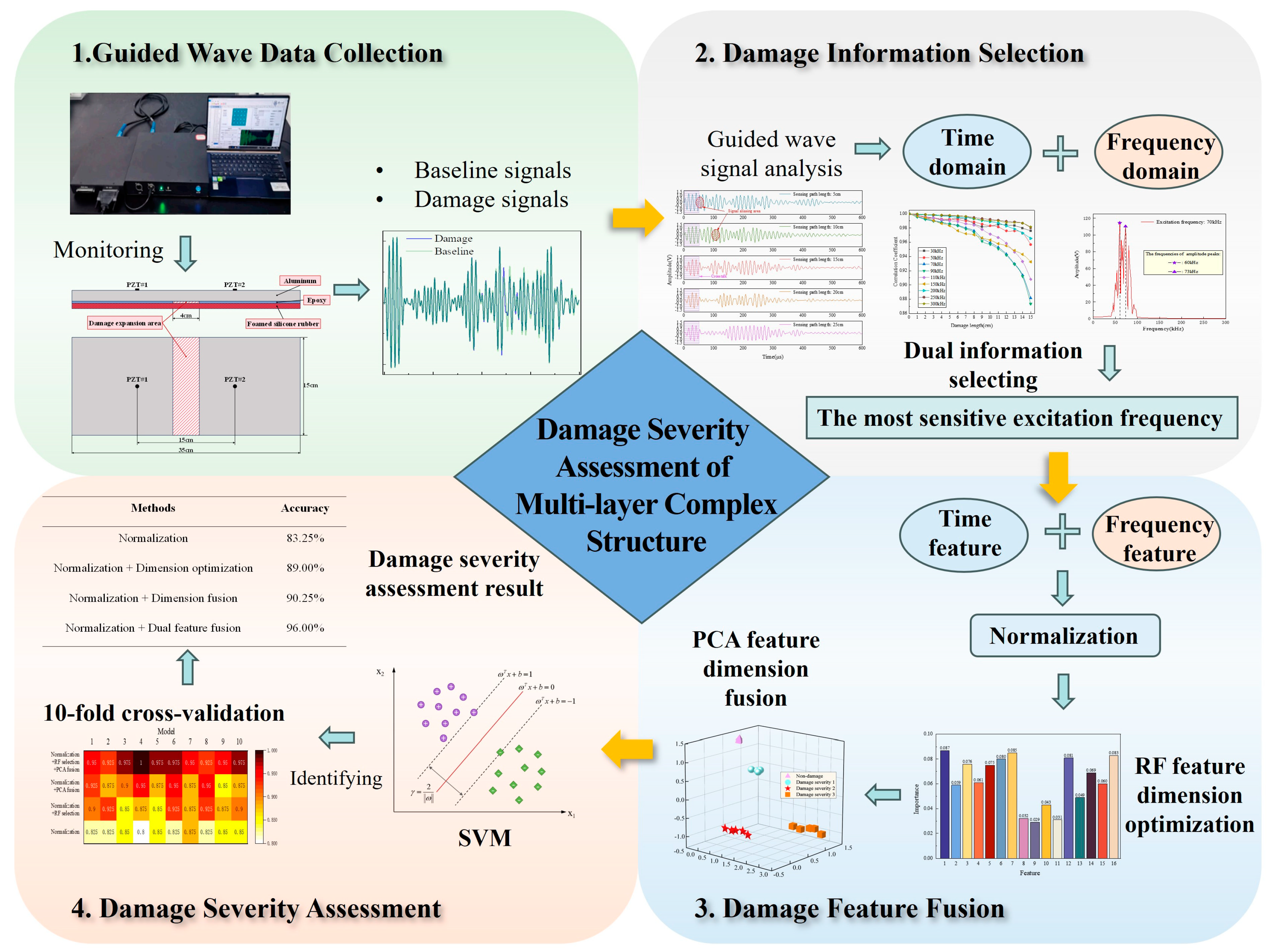
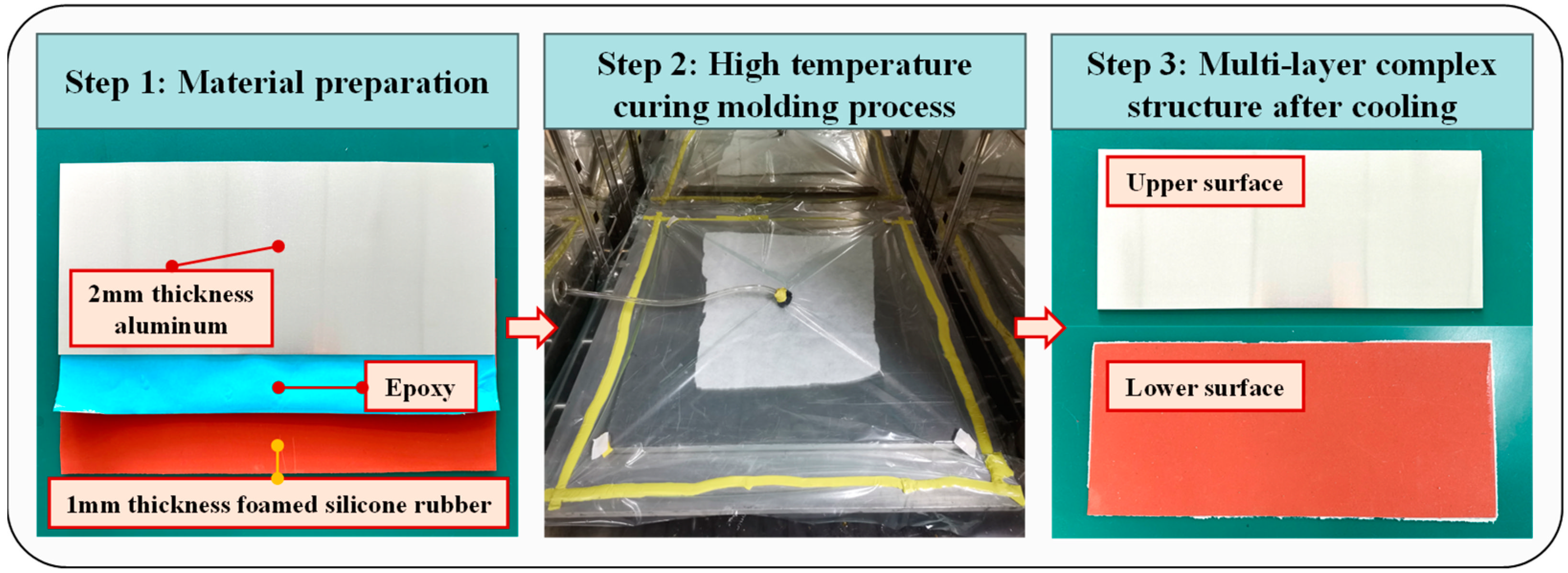
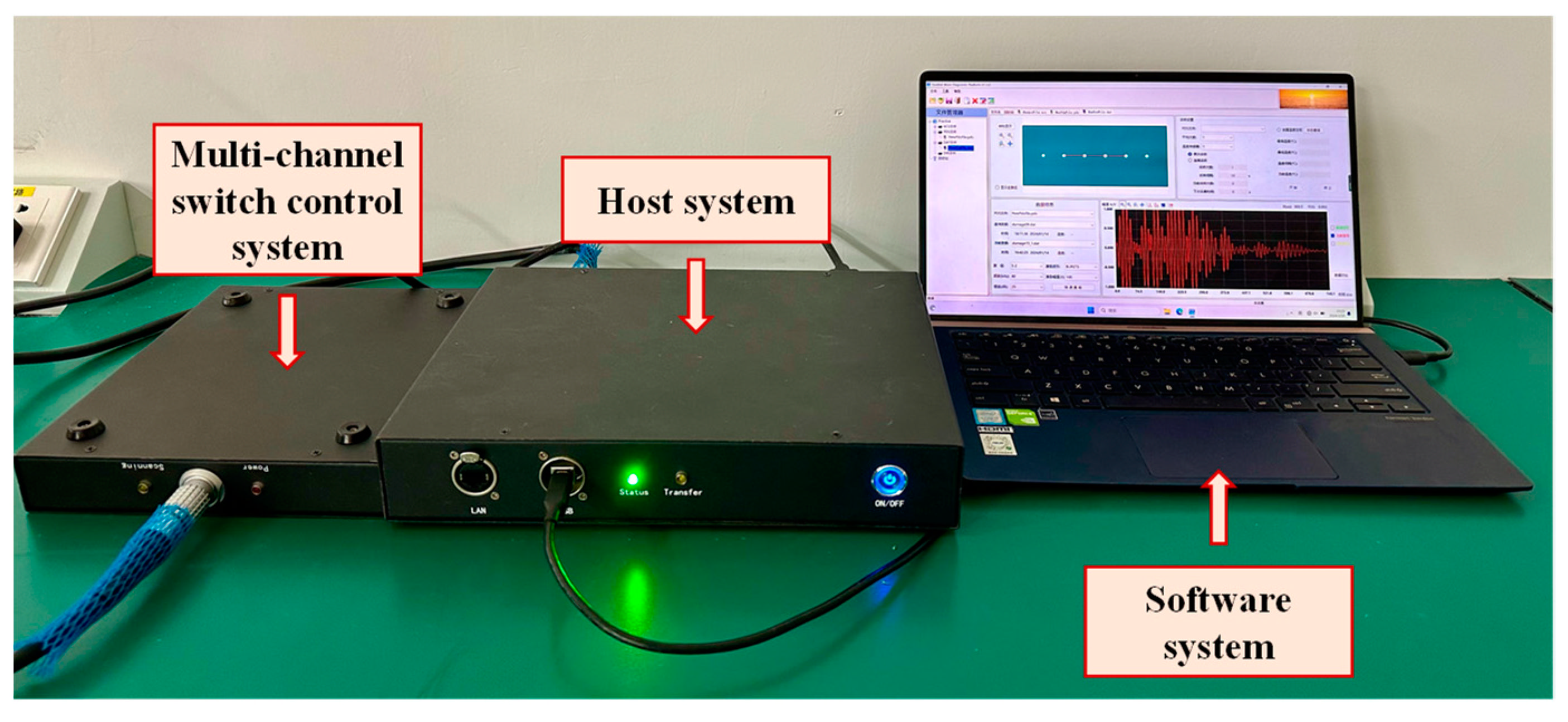

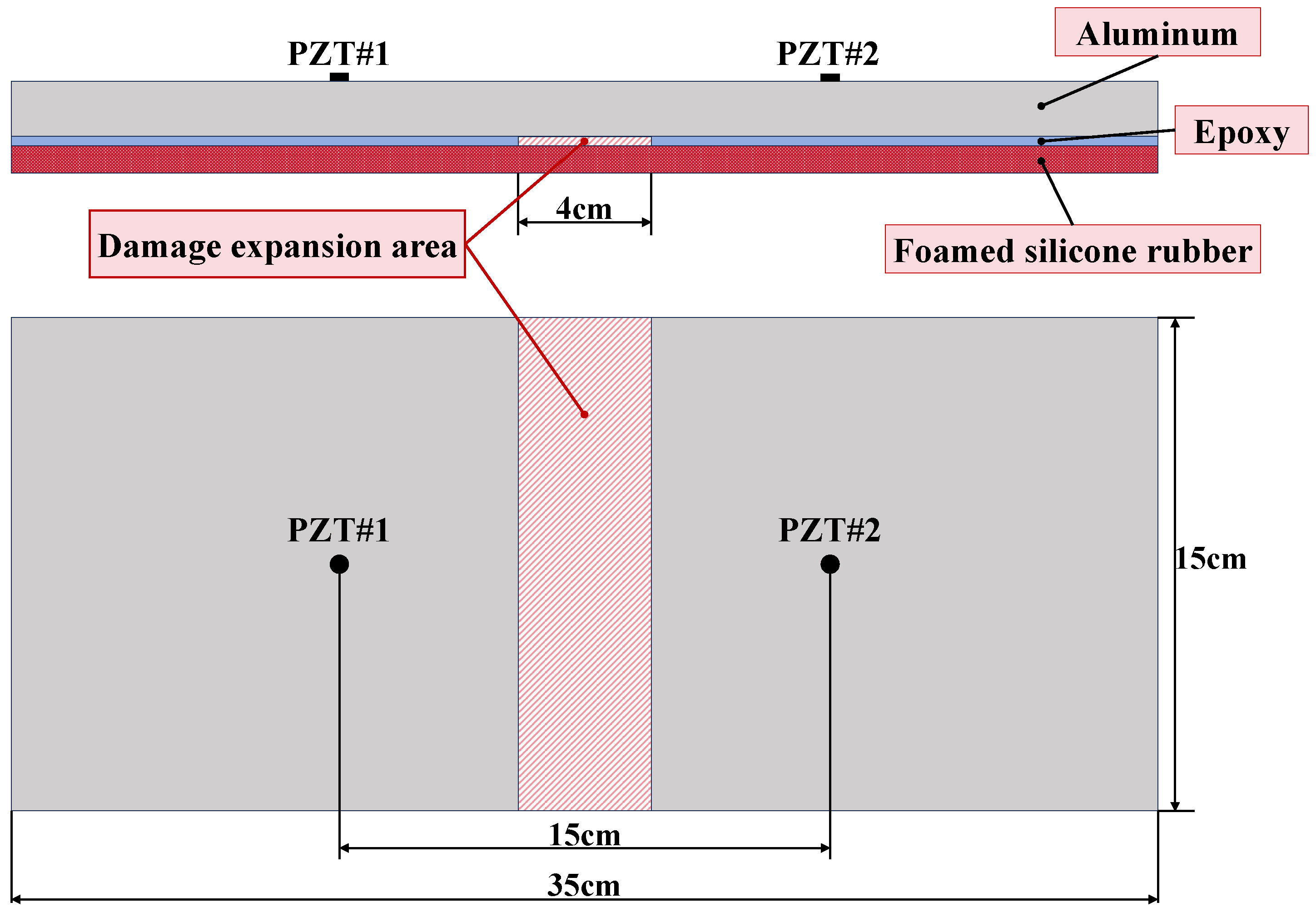
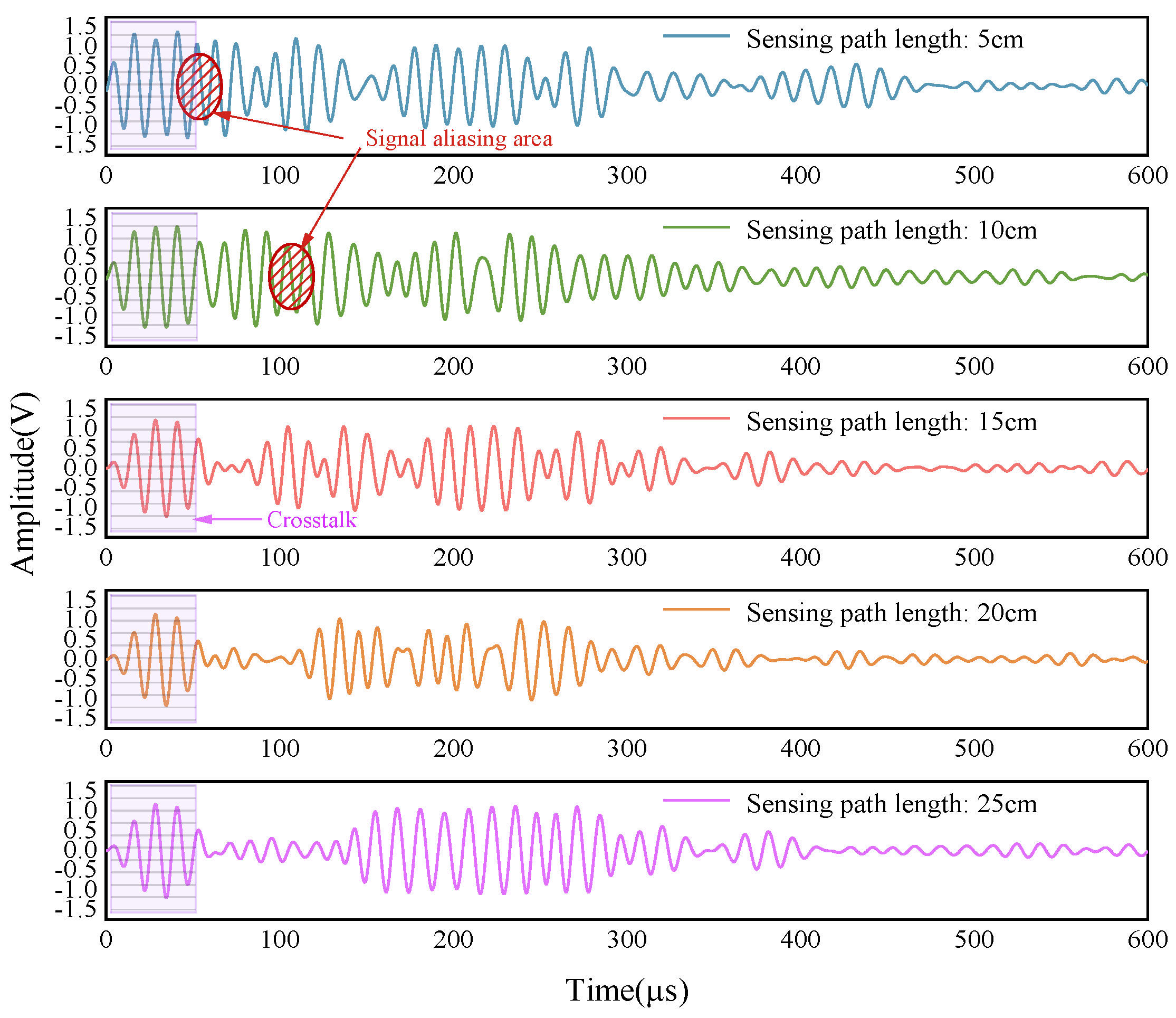
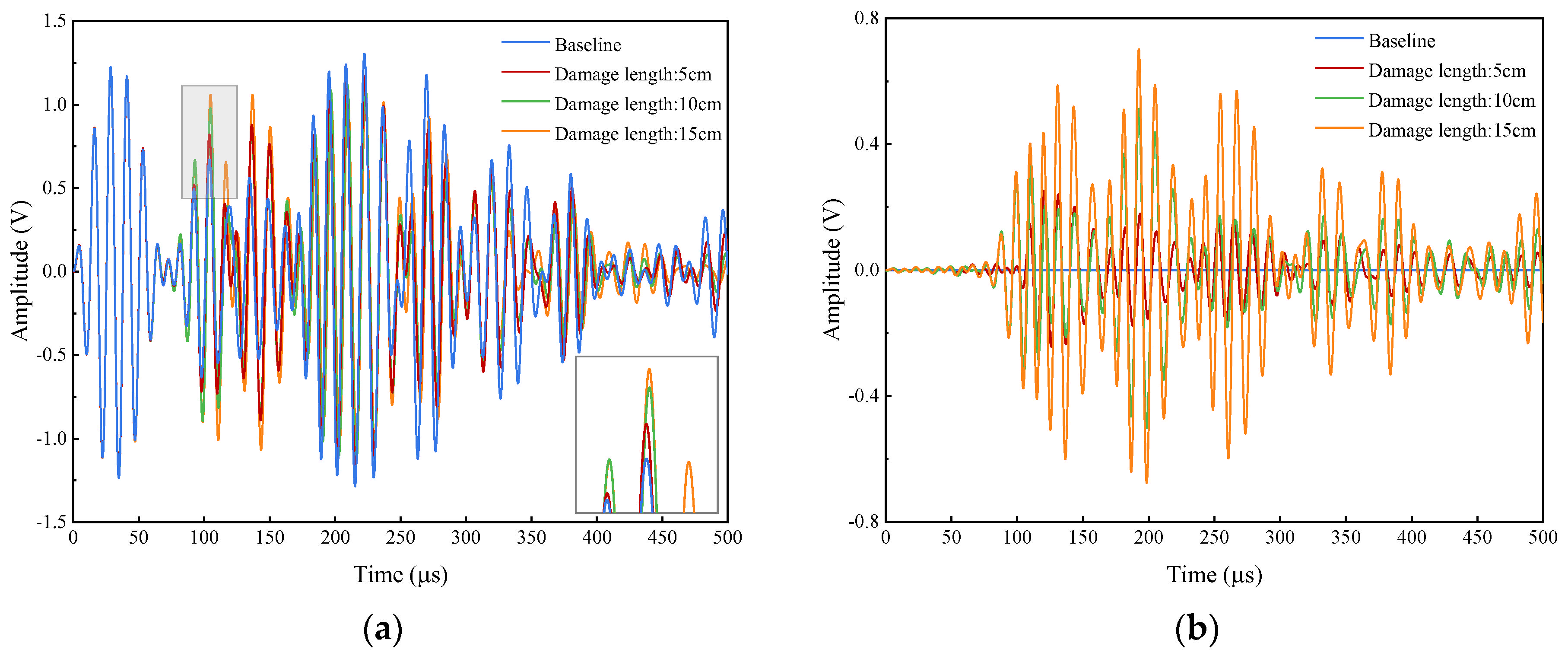

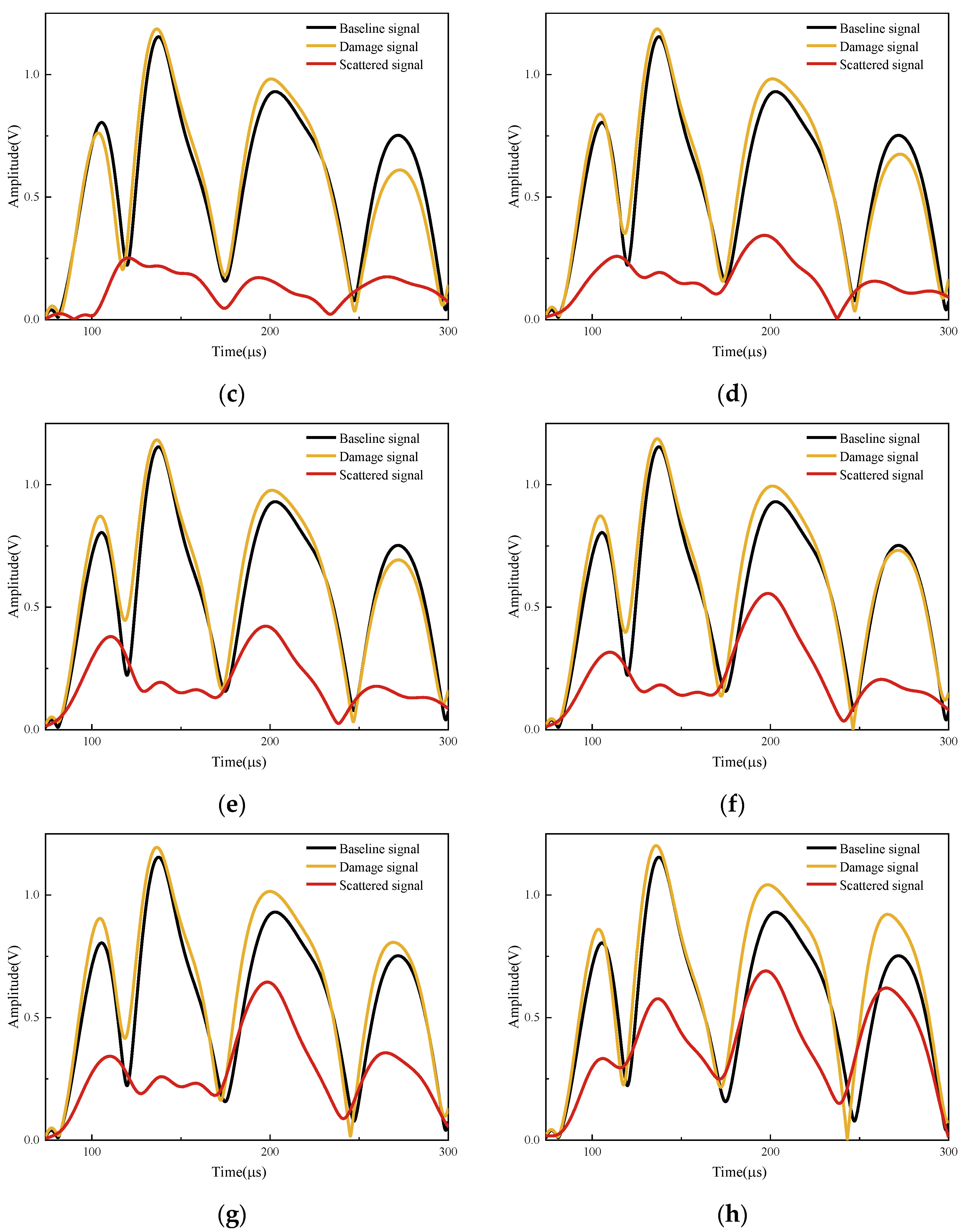
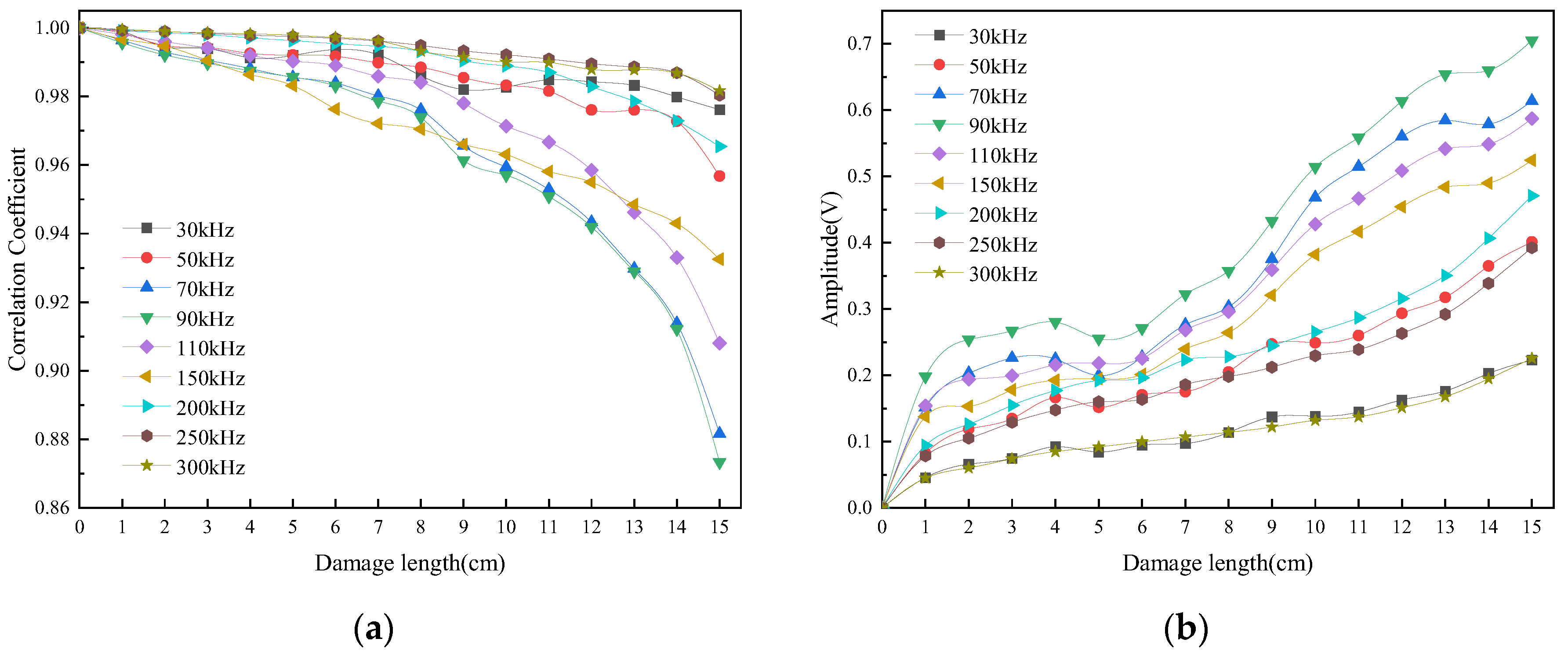
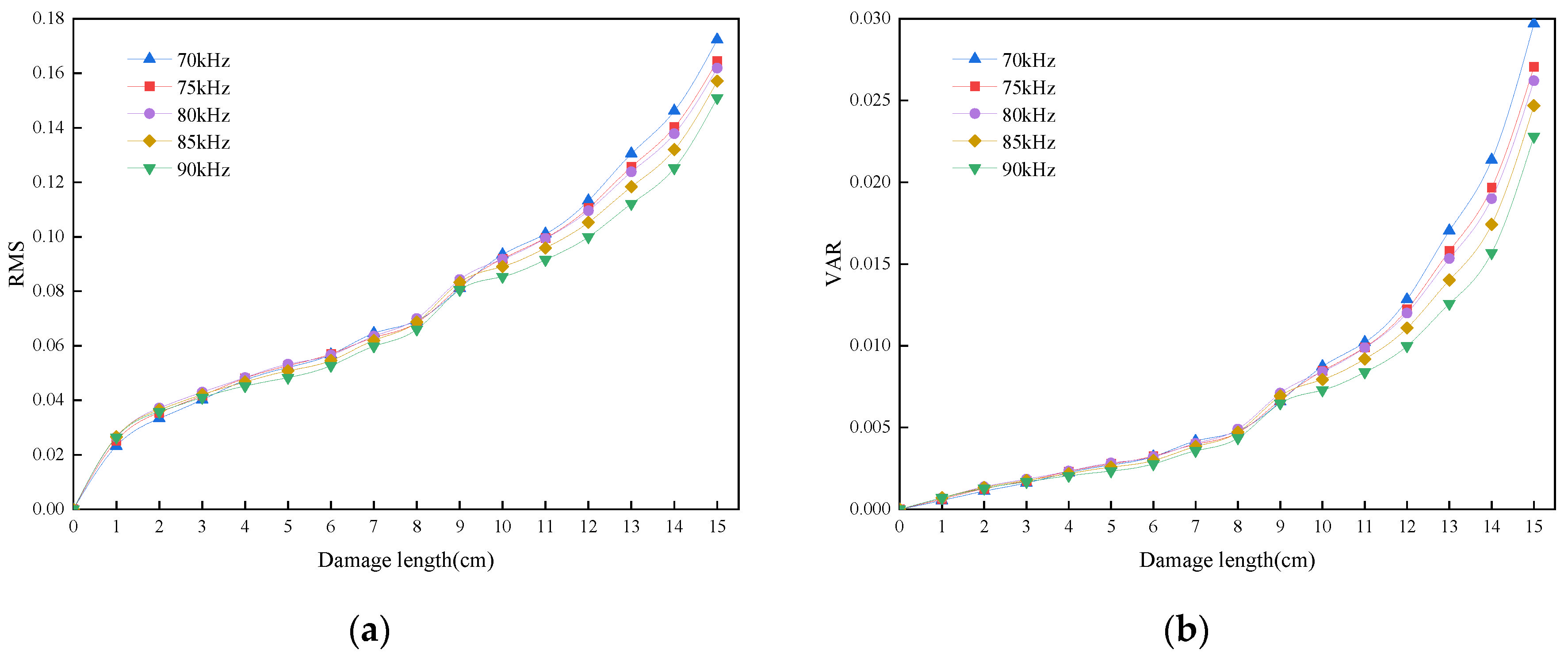


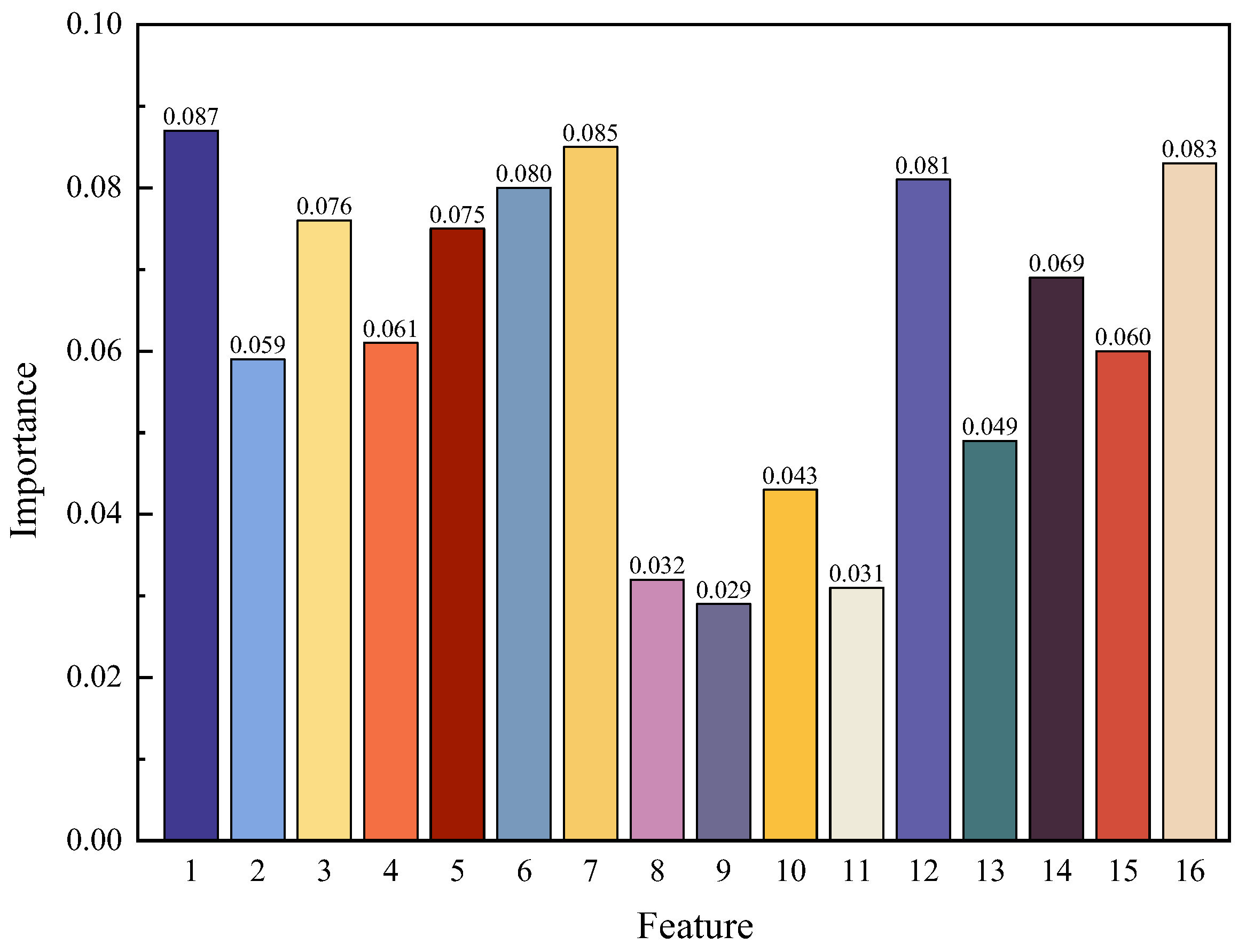

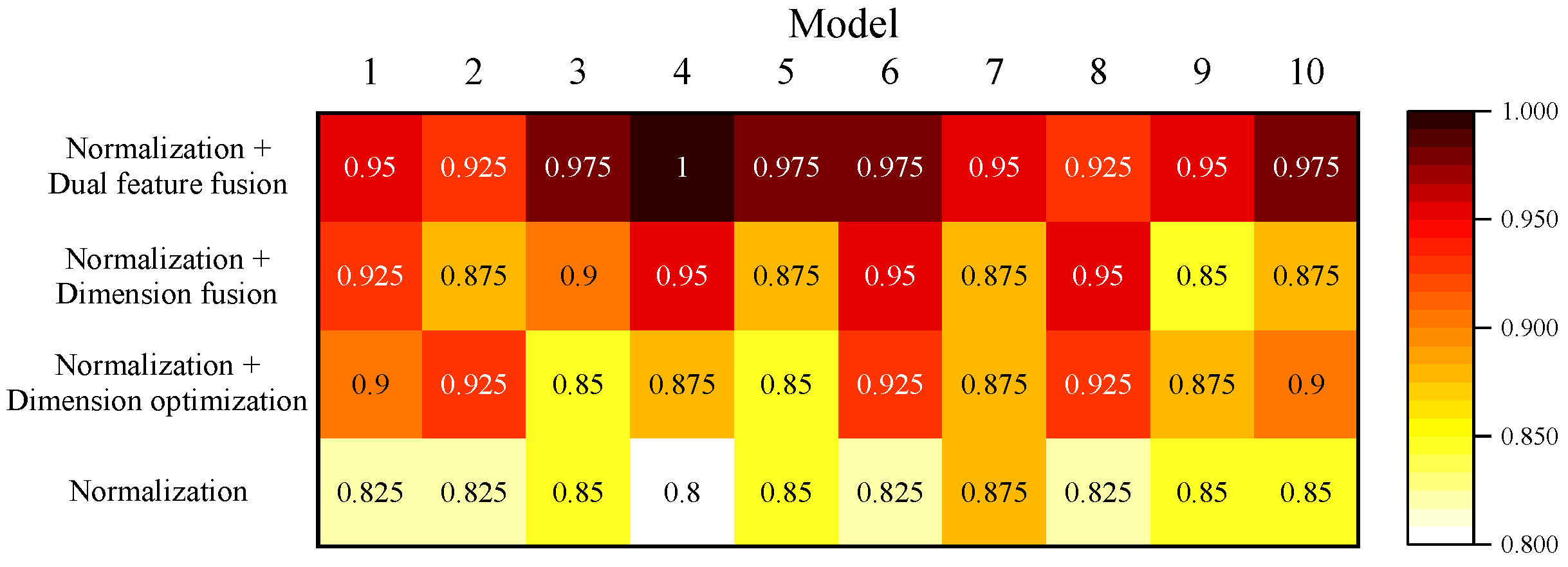
| Feature Number | Parameter | Calculation Equation | |
|---|---|---|---|
| 1 | Correlation coefficient | (5) | |
| 2 | Maximum value | (6) | |
| 3 | Peak-to-peak value | (7) | |
| 4 | Root mean square | (8) | |
| 5 | Variance | (9) | |
| 6 | Peak of the first wave | (10) | |
| 7 | Flight time of the first wave | (11) | |
| 8 | Peak of the second wave | (12) | |
| 9 | Flight time of the second wave | (13) | |
| 10 | SDT | (14) | |
| 11 | SST | (15) | |
| 12 | Envelope energy | (16) |
| Feature Number | Parameter | Calculation Equation | |
|---|---|---|---|
| 13 | Maximum value | (17) | |
| 14 | Energy | (18) | |
| 15 | SDS | (19) | |
| 16 | SSS | (20) |
| Method | Advantages | Limitations |
|---|---|---|
| RF feature dimension optimization | Robustness Ability to handle non-linear relationships | Easily overfitted Large time cost |
| PCA feature dimension fusion | Computationally efficient Highly interpretable | Easy to lose information Difficulty in capturing nonlinear relationships |
| RF + PCA dual feature fusion | Strong model generalization ability Low risk of overfitting Applicable to small sample data Low time cost | Some information may be lost |
| Technical Parameter | Value |
|---|---|
| Excitation frequency range | 10–1000 kHz |
| Conversion rates | 48 MHz |
| Output voltage range | Min: ±10 V; Max: ±60 V |
| Memory | 32,000 Samples |
| Sampling rates | 6, 12, 24, 48 MHz/s |
| Resolution | 12-bit |
| ADC range | ±1 V |
| Adjustment range | 10–40 dB, step: 1 dB |
| Date | Day 1 | Day 3 | Day 5 | Day 10 | Day 15 |
|---|---|---|---|---|---|
| Correlation index (Ci) | 99.87% | 98.62% | 97.97% | 96.45% | 96.40% |
| Model | 1 | 2 | 3 | 4 | 5 | 6 | 7 | 8 | 9 | 10 |
|---|---|---|---|---|---|---|---|---|---|---|
| Non-damage | 3 | 1 | 2 | 1 | 4 | 2 | 3 | 2 | 1 | 5 |
| Damage severity 1 | 6 | 8 | 10 | 8 | 10 | 7 | 8 | 10 | 6 | 10 |
| Damage severity 2 | 14 | 15 | 14 | 12 | 11 | 12 | 13 | 13 | 11 | 15 |
| Damage severity 3 | 18 | 19 | 20 | 17 | 20 | 16 | 16 | 19 | 18 | 20 |
| Methods | Accuracy |
|---|---|
| Normalization | 83.75% |
| Normalization + Dimension optimization | 89.00% |
| Normalization + Dimension fusion | 90.25% |
| Normalization + Dual feature fusion | 96.00% |
Disclaimer/Publisher’s Note: The statements, opinions and data contained in all publications are solely those of the individual author(s) and contributor(s) and not of MDPI and/or the editor(s). MDPI and/or the editor(s) disclaim responsibility for any injury to people or property resulting from any ideas, methods, instructions or products referred to in the content. |
© 2024 by the authors. Licensee MDPI, Basel, Switzerland. This article is an open access article distributed under the terms and conditions of the Creative Commons Attribution (CC BY) license (https://creativecommons.org/licenses/by/4.0/).
Share and Cite
Tu, J.; Yan, J.; Ji, X.; Liu, Q.; Qing, X. Damage Severity Assessment of Multi-Layer Complex Structures Based on a Damage Information Extraction Method with Ladder Feature Mining. Sensors 2024, 24, 2950. https://doi.org/10.3390/s24092950
Tu J, Yan J, Ji X, Liu Q, Qing X. Damage Severity Assessment of Multi-Layer Complex Structures Based on a Damage Information Extraction Method with Ladder Feature Mining. Sensors. 2024; 24(9):2950. https://doi.org/10.3390/s24092950
Chicago/Turabian StyleTu, Jiajie, Jiajia Yan, Xiaojin Ji, Qijian Liu, and Xinlin Qing. 2024. "Damage Severity Assessment of Multi-Layer Complex Structures Based on a Damage Information Extraction Method with Ladder Feature Mining" Sensors 24, no. 9: 2950. https://doi.org/10.3390/s24092950
APA StyleTu, J., Yan, J., Ji, X., Liu, Q., & Qing, X. (2024). Damage Severity Assessment of Multi-Layer Complex Structures Based on a Damage Information Extraction Method with Ladder Feature Mining. Sensors, 24(9), 2950. https://doi.org/10.3390/s24092950







